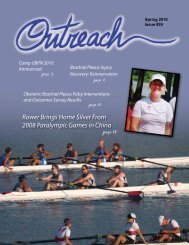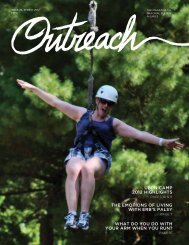Straight Talk Siblings
Spring 2007 Outreach (PDF) - United Brachial Plexus Network
Spring 2007 Outreach (PDF) - United Brachial Plexus Network
You also want an ePaper? Increase the reach of your titles
YUMPU automatically turns print PDFs into web optimized ePapers that Google loves.
BPI Research<br />
Spontaneous Recovery Research by the<br />
Doctors at Leiden University Medical Center<br />
One of the strategic goals of UBPN is to get an accurate and realistic count of incidence and prevalence of brachial plexus<br />
injuries. The most recent medical article that addresses the issue of permanence or resolution of obstetrical brachial plexus injury is<br />
by the brachial plexus team at Leiden University Medical Center at Leiden in the Netherlands.<br />
The following abstract is for the full text of an article published by Drs. Willem Pondaag, Martijn J.A. Malessy, J. Gert van Dijk<br />
and Ralph T.W.M. Thomeer in Developmental Medicine and Child Neurology 2004 46: 138-144. We have received permission to<br />
print the abstract but not the full text of the article. Full text of the article is available via local public or university libraries, through<br />
Inter Library Loan if they do not carry the journal.<br />
Abstract<br />
The natural course of obstetric brachial<br />
plexus palsy (OBPP) is generally<br />
considered to be favourable, with<br />
complete or almost complete recovery<br />
stated to occur in over 90% of patients.<br />
The validity of this presumption is<br />
important if one is to ensure that patients<br />
are treated appropriately, that parents<br />
of OBPP infants receive accurate<br />
information on prognosis and that a<br />
standard is set for epidemiological<br />
comparison of different treatment<br />
modalities.<br />
In order to obtain a scientifically<br />
– based outcome figure we performed a<br />
systematic literature review of the natural<br />
history of OBPP. In such a systematic<br />
review, all the available literature is<br />
explored to identify papers that were<br />
published in medical journals throughout<br />
the world, and to evaluate the scientific<br />
quality of these papers. In this case, the<br />
MEDLINE database was used to search<br />
for papers published from 1966 to 2001.<br />
Four quality criteria were applied.<br />
1. The study design should be<br />
prospective, and not retrospective. This<br />
means that the study does not look back<br />
in time, but patient cases are collected<br />
from a specified moment onward. In<br />
prospective studies patient cases are less<br />
likely to get overlooked (inclusion bias).<br />
2. The study population should be<br />
constituted on a demographic basis.<br />
Results based on referrals to specialized<br />
centres or on hospital records may be<br />
biased by selection towards more severe<br />
cases.<br />
3. Follow–up should be sufficiently<br />
long and complete. Three years was<br />
considered as the minimum, because<br />
the end stage of recovery might take<br />
up to three years, and secondly, the<br />
neurological investigation of younger<br />
children is difficult to measure. At least<br />
90% of the patients should be available<br />
for follow-up.<br />
4. Assessment of the end stage<br />
of recovery should be accurate and<br />
reproducible, preferably using a<br />
specialized pre–defined assessment<br />
protocol, and not imprecise classifications<br />
like ‘good’, ‘fair’ or ‘incomplete.’ Each<br />
of these four items scored one point.<br />
A total of 1,020 papers were screened<br />
using title, keywords and abstract,<br />
resulting in 76 papers for evaluation.<br />
Thirty–four articles failed to meet any<br />
quality criterion. Thirty–five papers<br />
received one point, seven received two<br />
points. None of the reports gained more<br />
than two points. The studies that most<br />
closely matched our quality criteria<br />
reported an incomplete recovery in 20<br />
to 30% of children. This does not mean<br />
that 20 to 30% of children need surgical<br />
correction, just that their function is not<br />
‘normal.’<br />
From this systematic literature review,<br />
it can be concluded that the quality of the<br />
studies that investigate the natural history<br />
of OBPP is poor. Therefore, the often–<br />
cited excellent prognosis for this type of<br />
birth injury cannot be considered to be<br />
based on scientifically sound evidence.<br />
The rate of spontaneous recovery in<br />
OBPP may be worse than is generally<br />
believed.<br />
The Leiden University Medical Center serves as a tertiary referral center for nerve lesions in<br />
the Netherlands. They hold a weekly multidiciplinary out-patient clinic with representatives of<br />
the Department of Neurosurgery (Malessy, Thomeer and Pondaag), Department of Orthopedic<br />
Surgery (Nelissen), a child physiotherapist (Hofstede), occupational therapist (Campagne) and<br />
a rehabilitation specialist (van Wijlen, de Boer). They perform nerve surgery to treat obstetric<br />
brachial plexus lesions approximately 40 times per year. To date, they have surgically treated over<br />
350 children with obstetric brachial plexus lesions. In two other publications, they reported on<br />
results for shoulder function and hand function.<br />
Pictured at left: The Team at Leiden University Medical Center: (from left to right) Willem Pondaag, Martijn Malessy<br />
(neurosurgeons), Kees de Boer (rehabilitation specialist), Sophie Campagne (occupational therapist) and Prof<br />
Rob Nelissen (orthopedic surgeon). Members of the team who are missing in this photo: Prof Ralph Thomeer<br />
(neurosurgeon), Sonja Hofstede (child physiotherapist) and Rietje van Wijlen (rehabilitation specialist).<br />
UBPN Outreach<br />
8





